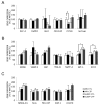Sleep-dependent gene expression in the hippocampus and prefrontal cortex following long-term potentiation
- PMID: 19389414
- PMCID: PMC2707503
- DOI: 10.1016/j.physbeh.2009.04.010
Sleep-dependent gene expression in the hippocampus and prefrontal cortex following long-term potentiation
Abstract
The activity-dependent transcription factor zif268 is re-activated in sleep following hippocampal long-term potentiation (LTP). However, the activation of secondary genes, possibly involved in modifying local synaptic strengths and ultimately stabilizing memory traces during sleep, has not yet been studied. Here, we investigated changes in hippocampal and cortical gene expression at a time point subsequent to the previously reported initial zif268 re-activation during sleep. Rats underwent unilateral hippocampal LTP and were assigned to SLEEP or AWAKE groups. Eighty minutes after a long rapid-eye-movement sleep (REMS) episode (or an equivalent amount of time for awake group) animals had their hippocampi dissected and processed for gene microarray hybridization. Prefrontal and parietal cortices were also collected for qRT-PCR analysis. The microarray analysis identified 28 up-regulated genes in the hippocampus: 11 genes were enhanced in the LTPed hemisphere of sleep animals; 13 genes were enhanced after sleep, regardless of hemisphere; and 4 genes were enhanced in LTPed hemisphere, regardless of behavioral state. qRT-PCR analysis confirmed the up-regulation of aif-1 and sc-65 during sleep. Moreover, we observed a down-regulation of the purinergic receptor, P2Y4R in the LTP hemisphere of awake animals and a trend for the protein kinase, CaMKI to be up-regulated in the LTP hemisphere of sleep animals. In the prefrontal cortex, we showed a significant LTP-dependent down-regulation of gluR1 and spinophilin specifically during sleep. Zif268 was down-regulated in sleep regardless of the hemisphere. No changes in gene expression were observed in the parietal cortex. Our findings indicate that a set of synaptic plasticity-related genes have their expression modulated during sleep following LTP, which can reflect biochemical events associated with reshaping of synaptic connections in sleep following learning.
Figures



Similar articles
-
Paradoxical (REM) sleep deprivation causes a large and rapidly reversible decrease in long-term potentiation, synaptic transmission, glutamate receptor protein levels, and ERK/MAPK activation in the dorsal hippocampus.Sleep. 2009 Feb;32(2):227-40. doi: 10.1093/sleep/32.2.227. Sleep. 2009. PMID: 19238810 Free PMC article.
-
Distinct modulatory effects of sleep on the maintenance of hippocampal and medial prefrontal cortex LTP.Eur J Neurosci. 2004 Dec;20(12):3453-62. doi: 10.1111/j.1460-9568.2004.03808.x. Eur J Neurosci. 2004. PMID: 15610178
-
Induction of hippocampal long-term potentiation during waking leads to increased extrahippocampal zif-268 expression during ensuing rapid-eye-movement sleep.J Neurosci. 2002 Dec 15;22(24):10914-23. doi: 10.1523/JNEUROSCI.22-24-10914.2002. J Neurosci. 2002. PMID: 12486186 Free PMC article.
-
Long-term potentiation of hippocampal afferents and efferents to prefrontal cortex: implications for associative learning.Neuropsychologia. 1993 Oct;31(10):1031-53. doi: 10.1016/0028-3932(93)90031-t. Neuropsychologia. 1993. PMID: 8290021 Review.
-
Plasticity of the hippocampal-prefrontal cortex synapses.J Physiol Paris. 1996;90(5-6):361-6. doi: 10.1016/s0928-4257(97)87920-x. J Physiol Paris. 1996. PMID: 9089514 Review.
Cited by
-
Muscarinic and nicotinic modulation of thalamo-prefrontal cortex synaptic plasticity [corrected] in vivo.PLoS One. 2012;7(10):e47484. doi: 10.1371/journal.pone.0047484. Epub 2012 Oct 30. PLoS One. 2012. PMID: 23118873 Free PMC article.
-
Sleep and plasticity.Pflugers Arch. 2012 Jan;463(1):111-20. doi: 10.1007/s00424-011-1031-5. Epub 2011 Sep 27. Pflugers Arch. 2012. PMID: 21947578 Free PMC article. Review.
-
Expression characterization and functional implication of the collagen-modifying Leprecan proteins in mouse gonadal tissue and mature sperm.AIMS Genet. 2018;5(1):24-40. doi: 10.3934/genet.2018.1.24. Epub 2018 Feb 7. AIMS Genet. 2018. PMID: 30417103 Free PMC article.
-
Accelerators, Brakes, and Gears of Actin Dynamics in Dendritic Spines.Open Neurosci J. 2009 Jan 1;3:67-86. doi: 10.2174/1874082000903020067. Open Neurosci J. 2009. PMID: 20463852 Free PMC article.
-
Changes in heart rate variability are associated with expression of short-term and long-term contextual and cued fear memories.PLoS One. 2013 May 7;8(5):e63590. doi: 10.1371/journal.pone.0063590. Print 2013. PLoS One. 2013. PMID: 23667644 Free PMC article.
References
-
- Abraham WC, Dragunow M, Tate WP. The role of immediate early genes in the stabilization of long-term potentiation. Mol Neurobiol. 1991;5:297–314. - PubMed
-
- Abraham WC, Mason SE, Demmer J, Williams JM, Richardson CL, Tate WP, Lawlor PA, Dragunow M. Correlations between immediate early gene induction and the persistence of long-term potentiation. Neuroscience. 1993;56:717–727. - PubMed
-
- Boehm J, Malinow R. AMPA receptor phosphorylation during synaptic plasticity. Biochem Soc Trans. 2005;33:1354–6. - PubMed
-
- Bozon B, Davis S, Laroche S. A requirement for the immediate early gene zif268 in reconsolidation of recognition memory after retrieval. Neuron. 2003;40:695–701. - PubMed
Publication types
MeSH terms
Substances
Grants and funding
LinkOut - more resources
Full Text Sources

